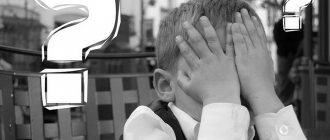Greetings, friends!
For most people, speech is the main means of everyday communication. At the same time, each of us knows very well that understanding a person when talking to him on the phone is sometimes more difficult than during a normal conversation. The reason is the lack of non-verbal interaction, because gestures and facial expressions are very important for understanding, but during a telephone conversation we do not see them. Today we will look in detail at what nonverbal communication is, what forms it takes, what meaning it has, and how to learn how to use it as effectively as possible.
Differences in the meanings of gestures in different cultures
Basic nonverbal gestures do not differ from each other in different cultures. Nodding your head means yes or no. This is an innate gesture, as it is used with equal meaning by deaf and blind people. Shrugging is a universal gesture that indicates a lack of understanding of the conversation. However, there are gestures whose meaning varies depending on the specific culture, country, nation, so the differences in the non-verbal language of other countries should be known.
Culture-specific gestures:
- "OK" gesture. The gesture, which gained popularity in America at the beginning of the 19th century, means “everything is fine”, “good” in all English-speaking countries, as well as in Europe and Asia. In France, this gesture is interpreted as “zero”, “nothing”, in Japan - “money”, in some countries of the Mediterranean basin this gesture is used to indicate a man’s homosexuality.
- "Thumbs up" gesture. In English-speaking countries, this gesture is used when trying to catch a passing car, and also to mean “excellent.” In Greece, this gesture asks a person to stop talking, and it carries a negative connotation.
- The "V - shaped finger sign" gesture with the hand turned back to the speaker is common in the UK and Australia to indicate a successful win, a solution to a problem, but for this designation. If during this gesture the hand is turned with the palm facing the speaker, then its meaning is “shut up.”
- Gesture "Goat". Used by representatives of musical subcultures as a sign of approval for the performer. In Italy the sign is considered an offensive innuendo and is used to mean "cuckold". In the American version of the deaf-mute language, a “goat” with its thumb pointed out to the side means “I love you.”
Kinesics
Kinesics is a branch of psychology that studies human emotional reactions from the point of view of his expressive movements (body movements). In this aspect, the following are considered as the main non-verbal means of communication: posture, expressiveness of gestures, facial expressions, gait features, gaze. It is believed that the information that the interlocutor wants to convey through speech may differ significantly from the feelings he actually experiences.
Pose
The postures a person takes during a conversation indicate his true intentions, more eloquently than gestures and facial expressions. Coping with your emotions is easy, but controlling postures when communicating is more difficult.
Modern psychologists divide postures into three types:
- Dominance - a person hangs over, tries to look down from above, sits leaning back, crossing his legs. Dependency – the individual lowers his head, sits with his knees tightly clenched, fiddling with his fingers.
- Closedness - the opponent clasps his fingers, closes himself by crossing his arms and legs, moves away from the interlocutor, and looks away. Openness - an individual who is inclined to communicate is distinguished by a relaxed posture, a wide smile, open palms, outstretched legs, and the torso turned towards the interlocutor.
- Confrontation is expressed by a raised chin, clenched fists, arms outstretched or placed on the hips, sides. Harmony is manifested in the speaker’s peaceful posture and good-natured gaze.
Gestures
With the help of these non-verbal elements of communicative communication, our ancestors have been trying to achieve mutual understanding since ancient times. Head movements and hand gestures can convey the emotional state of the interlocutor - his overexcitation, sadness, joy, anger, etc.
In the non-verbal sense, sign language is classified into the following types:
- modal – conveying the attitude of the conversation participants (trust/distrust, approval/disagreement, satisfaction/dissatisfaction);
- communicative - used for prohibitions, approval, farewell, greeting, attracting attention, etc.
- descriptive - express emotional coloring in the context of certain statements.
Facial expressions
Facial reactions are considered one of the main indicators of the true feelings of the interlocutor. According to research, if an individual maintains a still face, then information about his personal characteristics is lost by 15%. Psychologists have noted more than 20,000 different nonverbal interpretations of facial expressions. The main emotional states are:
- anger;
- fear;
- irritation;
- sadness;
- astonishment;
- joy;
- disgust.
When a person’s emotional state changes, the configuration of the entire face begins to dynamically change, mainly the lips, eyebrows and forehead.
Gait
The gait personifies the individual's position in life. By analyzing a person’s style of movement, one can judge the characteristics of his character, age, well-being and even profession. By the dynamics, rhythm and amplitude of the step, psychologists learn about such states as pride, suffering, illness, anger, determination, happiness, etc. A “light” gait indicates high spirits, joy, and self-confidence. “Heavy” – typical for gloomy people who are despondent or in a state of anger. “Sluggish”, “sluggish” - happens in suffering, insecure people.
Sight
Eye contact is a non-verbal signal that is the most important element in the art of communication. A direct, interested look endears the interlocutor and arouses sympathy. Looking too long is perceived as a challenge, excessive interest of the interlocutor. A short one, on the contrary, gives reason to believe that the opponent is insincere and is hiding information. It is considered optimal to exchange glances for 10 seconds.
It is also worth taking into account the national factor, for example, Asians (Japanese, Koreans) do not often look at faces, Europeans are distinguished by their direct gaze. Depending on the specifics, psychologists distinguish the following types of views:
- social – typical for secular, relaxed communication;
- business – used in a working atmosphere (when concluding business contracts, interviews, etc.);
- intimate – personifies interest, love, etc.;
- a sideways glance may indicate hostility, envy, criticism, or suspicion.
The eyes are capable of transmitting the most subtle signals of an individual's emotional state. Constriction/dilation of the pupils occurs in a person at an unconscious level, depending on his mood and state of the body. An excited person interested in something will have pupils dilated 4 times. A gloomy, depressive state leads to constriction of the pupils.
Main types of nonverbal communication.
Knowing the types of nonverbal communication, you can better understand the ways of their expression, since communication of this type is carried out by all senses, from which the communication channel is actually formed. Let's consider the main types of nonverbal communication:
- Kinesics - this element represents a set of body movements, gestures and postures used to complement expressive means of communication. The main elements of kinesics are facial expressions, postures, gestures and views that have a physiological or sociocultural origin. The gestures used must be understood unambiguously, since if the gestures are interpreted incorrectly, unpleasant circumstances may arise;
- Tactile behavior - it has been found that when communicating, all people use various types of touch to those interlocutors who are in close proximity. Different types of touch are of a different nature and have different, different effectiveness and significance. Tactile behavior can be divided into the following types: professional, ritual, friendly and loving. Each type of touch is necessary for a person to weaken or strengthen the process of communication. However, there are a number of factors that are certainly worth considering, since different cultures have different labels for non-verbal elements;
- Sensory is one of the types of non-verbal communication, which is based on sensory perception in all cultures. The attitude towards a partner is based on the sensation of the senses: smells, taste, perception of sound and color combinations, sensation of the interlocutor’s body and the warmth emanating from him. Thanks to all this, non-verbal communication with this partner will be established;
- Proxemics is a type of nonverbal communication based on the use of spatial relationships. This type of communication implies the direct influence of distances and territories on the manifestation of interpersonal relationships between people. As a result of some studies, four zones of nonverbal communication of a spatial type were identified: intimate, personal, social and public;
- Chronemics – this type involves the use of time in non-verbal communication;
- Paraverbal communication - the meaning of communication depends on the manifestation of the level of rhythm, intonation and timbre of the voice, which are used to directly convey the statement.
Postures and gestures
A person's attitudes and feelings can be determined by the way he stands or sits. Individual movements, as well as a set of gestures, will help to recognize them. It is much more pleasant and easier for people to communicate with those who are characterized by expressive motor skills and an animated, but at the same time relaxed facial expression.
Bright gestures indicate positive emotions. They encourage trust and sincerity. Moreover, if a person gestures excessively and often repeats his movements, then we can say that he is internally tense and, moreover, unsure of himself.
The ability to understand the gestures and postures of the interlocutor makes non-verbal communication more accessible and increases the level of mutual understanding. So, a person’s closed eyes, pinching the bridge of his nose and rubbing his chin will indicate concentration. Positively minded people tilt their heads slightly forward, touching their neck with their hand. Distrust is expressed by covering the mouth with a hand. If the interlocutor is clearly bored, then his body is slightly bent and relaxed, and his head is supported by his hand. When disapproving, a person’s movements are restless. He constantly straightens his clothes, shaking off “lint” from them.
Eye contact
The “language of gaze” is very diverse. Thus, completely open eyes characterize high receptivity of feelings and reason, general liveliness. Eyes that are too wide open/"bulging"/ indicate an increase in optical attachment to the surrounding world. Closed, “curtained” eyes are often a sign of inertia, indifference, arrogance, boredom or severe fatigue
A narrowed or squinted gaze means either concentrated close attention /observation/, or /in combination with a side glance/ cunning, cunning. A direct gaze, with the face fully turned towards the partner, demonstrates interest, trust, openness, readiness for direct interaction
A sideways glance, from the corners of the eyes, indicates a lack of full dedication, skepticism, and mistrust. A look from below (with a bowed head) indicates either an aggressive readiness for action, or (with a bent back) subordination, humility, and helpfulness. Looking from top to bottom / with the head thrown back / reveals a feeling of superiority, arrogance, contempt, and the search for dominance. An evasive gaze indicates uncertainty, modesty or timidity, and possibly a feeling of guilt.
The corners of the mouth drawn down symbolize a generally negative attitude towards life, a general sad expression on the face. Raised corners of the mouth reflect a positive attitude towards life, a lively and cheerful expression. If the mouth appears plump, it indicates increased vitality of the senses; soft - for sensitivity; sharp, precisely carved - for intelligence; firm - for certainty of will.
Proxemics
Proxemics is based on the construction of interpersonal relationships between individuals using spatial constraints. From the point of view of proxemics, nonverbal means of communicative communication include:
- Distance
- Orientations
- Distance
Psychologists have established several norms of “proximity” (spatial distances):
- Intimate – intended for the closest people (0-45 cm)
- Personal – allowing you to communicate with mutual friends (45-120 cm).
- Social – recommended for formal communication with unfamiliar people.
- Public – allows you to refrain from communication or speak in front of an audience.
An interlocutor who adheres to the above norms not only makes a favorable impression, but also feels more confident and comfortable.
These means of communication may vary depending on the nationality, social status and country of residence of the individual. Gender, age and personal characteristics of a person also matter.
Orientation
Such a proxemic component as orientation conveys various shades of a person’s emotional state, in terms of the angle of communication and the direction of the partner. Turning the toe and body can signal a person's attitude towards the opponent. A negotiator who decides to end the discussion involuntarily turns his body towards the exit. In business communication, seats at the negotiating table also matter:
- on the contrary, it characterizes a competitive-defensive position in which participants rigidly defend their point of view;
- on the one hand, it is the most convenient option for jointly discussing problems and developing a common solution;
- corner location - allows for a friendly and relaxed conversation;
- diagonally - the position indicates a lack of interest and reluctance of the participant in the conversation to interact.
Interpersonal space
Another important technique of nonverbal communication is maintaining interpersonal distance (space). In fact, the “limits of what is permitted” may differ depending on the place of residence, type of activity, and individual preferences of a person. However, there are some standard parameters to follow when making contacts:
- Intimate distance (up to 50 cm) is acceptable between close friends or relatives. Also, such an interpersonal distance is acceptable in sports that involve the contact of the bodies of opponents or partners.
- Interpersonal distance (50-120 cm) is acceptable for informal communication. In this case, tactile contact may or may not occur.
- Social distance (120-370 cm) is typical for social and business relationships. Tactile contacts are unacceptable in this case.
- Public distance (more than 370 cm) implies a formal exchange of politeness or abstinence from communication.
A little history
Nonverbal communication dates back to the dawn of humanity. Before the invention of language as a means of communication, communication between members of society was carried out only through body language. People conveyed the necessary information to each other using primitive gestures, which allowed ancient man to solve the problems that arose before him. For example, with his hands he pointed at prey or fellow tribesmen, depicted simple phenomena - thunderstorms and rain, and mimicked anger by threatening and grinning, baring his teeth.
Means of nonverbal communication
The main means of such communication is the body, which is capable of transmitting information through facial expressions, gestures, pantomime, changing position in space and the mise-en-scène of communication.
Due to the diversity and richness of facial capabilities, our body is capable of transmitting a huge number of images, becoming a powerful tool for conveying the necessary information to people around us.
It’s very easy to check this: just try to watch a movie in a foreign language that you don’t speak, and you will be surprised to note that you understand, if not the very essence of the characters’ conversations, then the message, the emotions that they put into the conversation, and even main idea and plot.
This is due to the fact that, in conditions of semantic deficit arising from ignorance of the language, we subconsciously monitor facial expressions, micro-gestures more closely than usual, and read the plot and emotional components from the movements and tone of voice of the characters.
Conscious and unconscious use of body signals
Nonverbal means of communication can be divided into two types based on the consciousness of use:
- nonverbal communication that we use consciously is those facial and gestural means that we use deliberately, that is, the tools we use to clearly convey specific information to the addressee;
- involuntary nonverbal behavior is those postures, gestures and changes in body position, as well as microgestures that we use unconsciously, uncontrollably. A specialist who knows how to read the signs of involuntary nonverbal behavior can tell more than the words we say.
Consciously used such means of communication provide a large layer of gestural, plastic and facial capabilities. Actors most clearly demonstrate this type of non-verbal communication tools: when playing a role, they use gestures and facial expressions to bring the image to perfection and give credibility to the game. The tools of good actors are very rich; they are able to remember and apply hundreds of different small poses, glances, turns of the head, which add variability to the words they use for the role.
Basic characteristics of nonverbal signals
Various parts of the body are used as tools to use and read such signals, but posture, gait, and plasticity are also important.
The nonverbal behavior of an open, self-confident subject is characterized by the following features:
- straight back, shoulders turned, good posture, free gait;
- raised head, confident look directly at the interlocutor;
- “open” gestures - relaxed arms, not closed on the chest or in a “lock”, legs not crossed;
- absence of fussy small gestures, attempts to cover your mouth or nose with your palm.
Nonverbal means of communication that demonstrate that a person is trying to hide something:
- drooping chin, tense shoulders, slight hunching;
- a gaze constantly moving from the interlocutor’s face to the floor or running over objects behind his back;
- “closed” gestures - arms crossed on the chest, a “leg to leg” pose, involuntary touching of the nose and lips with fingers, hands “housed” at chin level.
Such signs of nonverbal communication allow you to assess the degree of frankness of the interlocutor, help you take a sober approach to what he says, and decide whether to trust the person.
Flying gait
A beautiful gait is another non-verbal signal for men. The stronger sex is attracted by a straight back, laid back shoulders, and cat-like grace. Don't wave your arms too much - it looks awkward.
You can read a person's character by their gait. This applies not only to women, but also to men. A fearful person takes small steps. Soldier's march means a tendency to manipulate and command. Angular movements will tell about the duality in character. Such a person tries to defend himself, but may suddenly show aggression.
It’s bad when your legs move and your arms hang limply along your body. This shows helplessness and unwillingness to take the initiative. In non-verbal language it says: “I am weak, do everything for me.” Men don't like such women.
In the film “Marriage Italian Style,” Sophie demonstrated an amazing gait that became a textbook. Her husband, a director, taught her to walk beautifully. He came up with a very funny way to train. The actress had to walk between two rows of bedside tables and close their doors with her hips. Sophie practiced until the slamming of the doors was barely audible.
Features of public speech.
Public speaking is an oral form of speech. And the more it has all the characteristics of a live conversation, the stronger its impact on listeners. At the same time, this is a prepared speech, the basis for it, as a rule, is a written text. A public speech is pronounced with the aim of informing listeners and exerting the desired impact on them (persuasion, suggestion, inspiration, call to action, etc.).
Public speech is a monologue in form, but in essence it is a dialogue. In a dialogue, the interlocutor’s reaction is expressed very definitely, but during a public speech one must guess about it from the behavior of the listeners, their gestures, remarks, and the expression of their eyes. This must be done simultaneously with the speech. And here another difficulty comes into play - linguistic, or linguistic. The need to “cover broader thematic content” complicates the syntax of a monologue compared to a dialogue: sentences become structurally more complex; connecting them into a coherent piece of text is multi-stage; In order to maintain the structural and stylistic unity of the text as a whole, the speaker is forced to pay attention to both the end and the beginning of the utterance.
Another distinctive feature is the lively intonation of spoken language, i.e. the opportunity in an oral monologue to express one’s attitude to what is being said not only in words, but also in the timbre-tone coloring of the voice, a system of logical stresses and pauses, facial expressions, and gestures.
A journalistic text is often constructed as a scientific argument: an important social problem is put forward, possible ways to solve it are analyzed and assessed, generalizations and conclusions are made, the material is arranged in a strict logical sequence, and general scientific terminology is used. Publicistic speeches are distinguished by reliability, accuracy of facts, specificity, and strict validity, which brings it closer to the scientific.
The journalistic style also has much in common with the artistic style of speech. He is characterized by passion and appeal. In order to effectively influence the reader or listener, his imagination and feelings, the speaker or writer uses epithets, comparisons, metaphors and other figurative means, resorts to colloquial and even colloquial words and expressions, phraseological expressions that enhance the emotional impact of speech.
The most important requirement for journalism is accessibility
: It is intended for a wide audience and should be understandable to everyone.
Forms of verbal communication and barriers are not his way
When communicating verbally, we can use different forms and styles in order to convey certain information in a specific context and color. This can be clearly seen in the styles that are used in literature:
- Journalistic - the main goal of such a speech is to convey to people the idea, the essence of what happened.
- Scientific – distinguished by logic and clear statements using terminology and complex concepts.
- Official business is the dry language of laws, where everything is precise and without any epithets.
- Artistic - here it is possible to combine any words and word forms, jargons and dialect (dialectisms), speech is filled with unimaginable images and colors.
- Conversational - characterizes both individual dialogues in works and our communication with you when we meet an acquaintance.
Speech interaction can be divided according to the number of people who take part in it:
- Monologue (one person): speaking - at meetings in front of someone or reciting a poem in front of the class;
- report - important information, usually supported by numbers;
- report - similar to a report, but provides more extensive information and description;
- lecture – presentation of useful information to the audience.
Dialogue (two or more people):
- ordinary conversation - exchange of greetings and thoughts;
- discussion – discussion of a topic where the interlocutors represent different points of view;
- dispute – here, too, there are two positions between which the resulting conflict needs to be resolved;
- a debate is a discussion within the framework of science;
- interview - a conversation during which the employer thinks about whether to hire a person.
Despite the fact that we communicate in the same language, various barriers to verbal communication may arise:
For example, phonetic. The interlocutor may have a speech impediment, unpleasant diction, choose an unusual intonation, sprinkle words with parasites, etc... Semantic interference grows between people from different countries, with different mentalities, or even when raising children in different families. A logical barrier is if the interlocutors have different types of thinking, levels of development and intelligence. A stylistic barrier is that the interlocutor incorrectly builds a chain of verbal communication to convey information
First we need to attract attention to what we want to say, to interest. Then lay out the basic information; answer questions that your opponent may have
After this, give him time to think about it so that he can draw conclusions or make a decision.
Development of communication skills
Reading can help you improve your nonverbal communication skills.
A book, report or presentation on the topic of communication between people will broaden your horizons and draw attention to the subtleties of human behavior that were previously overlooked
- The book “Psychology of Emotions. I Know How You Feel" by Paul Ekman will reveal the secrets of what is most important in managing behavior. The book is distinguished by entertaining and useful content, it will teach you to recognize, evaluate, control and correct emotions.
- The book “The Psychology of Lies. Fool Me If You Can,” also written by Paul Ekman, will help you identify and respond to lies. The book is rich in examples of microexpressions and microgestures, knowledge of which will help bring deception to light. Useful reading for anyone who does not want to become a victim of manipulation or lies.
A presentation or report as part of training sessions on communication and nonverbal communication contains maximum useful information in a concise form
They will briefly and colorfully explain the essence of non-verbal communication, clearly demonstrate postures, gestures and decipher their meaning, and draw attention to the most important non-verbal means. Special literature, games and exercises during the training will help develop the skills of non-verbal interaction with others and understand the patterns of communication
Fake signals
Nonverbal signals cannot be completely controlled, which means they are very difficult to fake. They come from the area of the unconscious, and if a person plays, then inconsistencies in words and facial expressions will be visible. He will not be able to completely relax, which is also easy to notice.
It happens that the interlocutor answers in the affirmative, but in fact does not think so. Notice that his head will shake unconsciously, as if saying the opposite. Your intuition is an excellent assistant in the difficult task of recognizing the correspondence between verbal and nonverbal signals. Don’t brush it off, but on the contrary, listen.
Nonverbal communication: facial expressions
The facial muscles react to all thoughts and emotions affecting a person. Thus, facial expressions are one of the most important mechanisms of nonverbal communication. If a person is trying to hide his thoughts and emotions from you, his facial expressions will still give him away. The table shows the correspondence of sensory manifestations of facial expressions.
| Feeling | Mimic manifestation |
| Astonishment |
|
| Fear |
|
| Anger |
|
| Disgust |
|
| Sadness |
|
| Happiness |
|
Example of nonverbal communication
At one university, an experiment was conducted in psychology classes. The audience, which consisted of married couples, was divided into two groups by gender and was given video recordings of different versions of babies crying. Then they were asked to explain their meaning. Most women who had children accurately deciphered them (hunger, wet diapers, pain, etc.), while men did not see much difference in the crying options. This led to the conclusion that women, being more sensitive and observant, interpret non-verbal gestures more easily. It’s more difficult for men to do this; they need specifics, and not all sorts of sentimental experiences. Of course, there are exceptions.
This case also explains why it can be difficult for the stronger sex to tell a lie to his wife, who seems to read the real state of affairs in her eyes.
Speech activity: forms of language
Speech activity is a situation in which communication between people occurs through verbal components, language. There are different types:
- Writing is recording the content of speech on paper or electronic media.
- Speaking is the use of language to convey a message.
- Reading is the visual perception of information captured on paper or a computer.
- Listening is the audio perception of information from speech.
Based on the speech form, communication can be oral and written. And if we consider it depending on the number of participants, it can be divided into mass and interpersonal.
There are also literary and non-literary forms of language, which are unique to each nationality; they determine the social and cultural status of the nation. Literary language is exemplary, structured, with stable grammatical norms. It is also presented in two forms: oral and written. The first is the speech that sounds, the second can be read. At the same time, oral appeared earlier, it was the original one that people began to use. Non-literary speech – dialects of individual nationalities, territorial features of the oral language.
But nonverbal communication is of greatest importance in the psychology of communication. A person unconsciously uses various signs: gestures, facial expressions, intonation, posture, location in space, etc. Let's move on to consider this large group.
Voice timbre and intonation
Correctly reading these non-verbal signals will help you learn to understand a person’s “messages” by reading between the lines. The list of such features includes unfinished sentences and frequent pauses, pitch of voice, speed of speech and construction of phrases. So, we can talk about anxiety if a person’s tone of voice decreases. His speech becomes frequent and abrupt. Confirmation of enthusiasm is a high tone of voice. Speech in this case is confident and clear. When tired, the tone of voice is low. Towards the end of each sentence the person lowers his intonation. Uncertainty is indicated by frequent pauses, mistakes in words, and a nervous cough.
Nonverbal means of communication. Part 1
Currently, there is a huge amount of information on the Internet on the topic “Nonverbal means of communication”. If you wish, you can read special articles and learn to determine the meaning of a particular pose, the meaning of a particular gesture. If you are attentive, body language will tell you much more about your interlocutor than he himself.
But it is one thing to recognize the nonverbal language of others, and quite another to control our nonverbal means to create the image we desire.
It is known that nonverbal communication occupies an important place in our lives. We very often use body language and body language when interacting with relatives, colleagues, friends, business partners, and in general, just strangers. Non-verbal means of communication also help in situations of public speaking, strengthening our speech and helping to quickly perceive the material.
Nonverbal means of communication also help in situations of public speaking, strengthening our speech and helping to quickly perceive the material.
How can you use body language and body language to enhance your performance?
How to properly and effectively manage your nonverbal language?
You will find material about this in the “Nonverbal means of communication” section.
A LITTLE THEORY
Verbal communication is communication using words or verbal communication.
Nonverbal communication is communication without words, but through body language.
Nonverbal means of communication are a system of signs that complement, enhance, and sometimes replace our speech.
FIVE WAYS OF NONVERBAL COMMUNICATION
- Optical-kinesthetic - based on the transmission of information through movements: facial expressions, gestures, human posture, his movement in space during communication.
- Paralinguistic – based on the volume, timbre, tonality, and intonation of a person’s voice.
- Extralinguistic - based on the rate of speech, the use of pauses, includes sighs, laughter, crying, etc.
- Situational is the place in which communication occurs.
- Visual – based on the interaction of interlocutors at the level of views.
You will find information about the importance of such methods of nonverbal communication as paralinguistic and extralinguistic in the “Speech Techniques” section. There you will also find a large number of exercises for developing your voice and all its components.
In the section “Nonverbal means of communication” we will focus on the most extensive group of signs of our body, which will certainly help each of you to strengthen interaction with the audience. Namely…
NONVERBAL COMMUNICATION
- Expressive movements - body posture, gait, gestures, facial expressions.
- Visual contact gaze – direction of gaze, its duration, frequency of eye contact.
- Spatial movements - orientation in the room, placement at the table, distance.
- Tactile movements - touching, shaking hands, patting.
We will talk about the importance of nonverbal communication in our lives in the next article. In the meantime...
HAPPY READING AND ENJOYING YOUR EXERCISES!
Distance in sign language
Do you want to understand how your interlocutor treats you? Move closer to him. If you are pleasant to your counterpart, he will remain in place and smile. If rejected, the person will automatically move away. He doesn't trust you, and it will be difficult to move into a closer phase of communication.
Nonverbal cues in communication are very important. If they coincide with your words, then the person will trust you on an intuitive level. By understanding other people's non-verbal signs, you will be able to “read” your interlocutor like a book.
Nonverbal signals in communication will help you attract the attention of the opposite sex. A girl who has good body language has a better chance of attracting the guy she likes. In addition, if a lady is familiar with the concept of non-verbal signals of sympathy and knows how to distinguish them, she will be able to protect herself from gigolos, swindlers and pick-up artists. By reading the signals that the body gives us, we can find out what the young man is up to and make sure whether he really feels sympathy.
However, sign language is useful not only in amorous matters. A person who makes a career gets a chance to interact better with his superiors or outperform his colleagues if he has such knowledge.
Non-verbal communication
Nonverbal communication – “body language”. He does not use speech, but uses other means, which allows him to perform important functions:
Focusing on what's important. Without mentioning unnecessary words, a person can use a gesture or take a certain position, which will indicate the significance of the moment. Controversy
The speaker says the same words, but thinks in completely opposite ways. For example, a clown on stage is unsmiling and unhappy in life. The slightest facial movements on his face will help you understand this. Just like exposing a lie if a person tries to hide it behind an insincere smile. Addition to what was said. Sometimes each of us accompanies enthusiastic words with a gesture or movement that indicates the strong emotionality of the given situation. Instead of words. The subject uses gestures that everyone can understand, saving time. For example, shrugging your shoulders or giving directions requires no further explanation. Repeat and enhance the effect of speech. A verbal appeal is sometimes quite emotional, and non-verbal means are designed to emphasize the firmness of your statement. Nodding or shaking the head when answering “Yes” or “No” shows confidence and assertiveness.
Types of nonverbal means
A large group consists of kinesthetics - external manifestations of a person’s feelings and emotions during communication. This:
- Facial expressions
- Poses
- Gestures
- Pantomime
Gestures and postures
The interlocutors’ assessment of each other occurs long before the conversation itself begins. Posture, gait, and gaze can in advance reveal a person who is insecure or, on the contrary, self-confident, with claims to power. Gestures usually emphasize the meaning of speech, give it an emotional tint, and place accents, but their excess can also ruin the impression, especially in a business meeting. In addition, for different nationalities the same gestures mean completely opposite phenomena.
Intense gestures determine a person's emotional state. If his movements are sharp, there are many of them, then the subject is overexcited, agitated, overly interested in conveying his information to the opponent. Which can be both an advantage and a significant disadvantage, depending on the circumstances.
Posture plays an equally important role. If the subject has his arms crossed over his chest, then he is skeptical and does not really trust you. Perhaps he is closed, does not want communication in principle. If the interlocutor turned his body towards you and did not cross his arms and legs, then, on the contrary, he was open and ready to listen. In psychology, for effective communication, it is recommended to mirror the opponent’s posture in order to achieve relaxation and trust from him.
Facial expressions
A person’s face is the main source of information about his internal state. A frown or a smile are the factors that determine further communication with the subject. Eyes truly reflect human essence. There are seven types of basic emotions, each of which has its own characteristic signs: anger, joy, fear, sadness, melancholy, surprise, disgust. They are easy to remember, identify and then observe in people to better understand the mood of others.
Pantomime
This includes gait. A closed or upset person most often slouches, lowers his head, does not look into the eyes, but prefers to look at his feet. Angry people walk with sharp movements, hasty but heavy. A confident and cheerful person has a springy gait or a long stride. It changes depending on how you feel.
There is a section of nonverbal means that takes into account the distance between speakers - proxemics. It determines the comfortable distance between the interlocutors. There are several communication areas:
- Intimate - 15-45 cm. A person allows only those closest to him there. Intrusion by strangers may be perceived as a threat requiring immediate protection.
- Personal – 45-120 cm. Acceptable for good friends and colleagues.
- Social and public – typical for business negotiations, major events and speaking at them from the podium.
Takeshika is a section of communication dedicated to the role of touch. If you apply them incorrectly, without taking into account the difference in social status, age, gender, then you can find yourself in an awkward situation, even become the cause of a conflict. A handshake is the most harmless form of touch. This is especially true for men who use it to test the strength of their opponent. They choose, so to speak, which of them is the most powerful. Sometimes uncertainty, or disgust, or compliance is easily revealed when a person only shakes his fingertips.
How to recognize the sincerity of a smile
Any person considers a smile a sign of sympathy and good attitude. It influences the subconscious in any case, whether you want it or not. Therefore, it is so important to distinguish between a real manifestation of sympathy or a fake, forced smile, with the help of which they want to achieve something from you.
Asymmetry is a bad sign. A real smile is even, but when a person “pulls” it, one corner of the mouth may be higher than the other. Showing teeth is also considered a sign of trust and affection. A sign of goodwill is that the interlocutor is not embarrassed to laugh in front of you.
Irony. Ironic laughter is characteristic of people who generally treat you well, but it means that at the moment you look comical. The smile is slightly distorted, and one eye may be squinted.
Sarcasm is a blatant display of disrespect and arrogance. The person considers you beneath him and openly laughs at you. Signs of sarcasm:
- crooked smile;
- arrogant squinting of the eyes;
- hostility in the voice.
How to understand nonverbal signals of boredom? This is especially necessary if a person’s profession involves constant public speaking. It is also important for sales agents to understand whether a potential buyer is listening to his speech or is just pretending. If your opponent is bored, he is unlikely to be able to hide it: body language does not deceive.
Exercises used to restore speech
Gymnastics are done daily, making sure that the movements performed are correct.
- Stretch your lips with a tube for 5 seconds, then relax for 2 seconds.
- Alternately grab and bite your upper and lower lips with your teeth. 5 seconds for each “bite”.
- Stick your tongue as far forward as possible for 3 seconds, stretch your neck, relax.
- Lick your lips in one direction or the other several times, then in a circle.
- Stick your tongue out into a tube forward for 3 seconds, then relax for three seconds.
Exercises in the form of pronouncing tongue twisters are effective in restoring speech.
When learning to speak after a stroke, it is important to constantly be in contact with a speech therapist; classes with the patient at home are carried out only with his permission. Non-professionals easily give excessive speech load and exercises that are too difficult for the patient
At the beginning of classes, exercises should be performed for 7–15 minutes, gradually increasing the duration to half an hour. You can’t exercise for more than thirty minutes - overwork will lead to regression.
Human life is a constant interaction with other people. The importance of nonverbal communication cannot be overestimated. Communication skills are useful in everyday life and in professional activities, since it is non-verbal communication that takes up the majority of everyday interaction with others.
https://youtube.com/watch?v=aI0sR6FgmN4
Previous articlePreviousNext articleNext
Recommendations for men
If you smile too often, you may be perceived suspiciously, therefore, as for the opposite sex, it is important to be able to laugh sincerely. If you remember, the psychology of the weaker sex is such that they easily read non-verbal information; this skill is inherent in nature so that the mother can recognize the needs of her baby
Therefore, the most basic recommendation is to be sincere. When communicating, show as many open gestures as possible, which indicate a willingness to be honest and open. For example, do not hide your palms, do not cross your legs... Do not focus your attention on other girls, otherwise the interlocutor will catch your gaze, which will not have a positive effect on the relationship . There is a gesture that indicates your self-confidence and inner strength, it is called the “pyramid”, this is when the fingertips and palms are joined together. So, if you want to conquer your interlocutor and not give away your excitement, use it during meetings. To make you more inclined to have an intimate relationship, you can use this technique: place your index finger on your lower lip, hold it for a couple of seconds, then lightly tap the lip a couple of times and remove it. This will reinforce the message and desire to move to a new level in the girl’s subconscious. Listen carefully, try not to interrupt, lean your body forward slightly to demonstrate your interest. You can put your thumbs behind the belt, and if you are sitting, keep your hands on your hips, or stretch your legs forward, this will create a feeling of your disposition towards the girl, as well as a manifestation of love and a demonstration of masculinity.
Nonverbal signals as the only means of communication
The importance of non-verbal communication cannot be overestimated - it remains the only means of exchanging information in cases where:
- people do not know each other's language even at a basic level;
- people do not have the physical ability to make sounds.
If in the first case it is subsequently possible to establish a higher level of communication through the gradual study of each other’s languages, then in the second, various types of non-verbal communication come to the fore and become the only possible means of contact.
In situations where people who are physically capable of producing sounds find themselves in an environment that does not allow them to pronounce these sounds, it is the tools of nonverbal communication that come to the fore. These signals are used in scuba diving (dive signals), in noisy rooms (rolling shops, engine rooms), while hunting, and when participating in hostilities (ambushes).
Nonverbal errors
Even if a person is not familiar with the intricacies of nonverbal communication, he subconsciously rejects and rejects some unpleasant moments. As a rule, communication with your interlocutor does not work out if you make the following mistakes:
Hidden palms. Keeping your hands in your pockets, behind your back, or simply crossed means closing yourself off from your interlocutor. This suggests to him that you are insincere or afraid. If you find it difficult to maintain an open posture, pick up an object (a pen or a folder), but do not hide it. Look away. Looking at the floor, around or at foreign objects is extremely wrong
It is important to make eye contact. You can only look away if you are showing something to your interlocutor (for example, a product or document)
But at the end of the presentation, be sure to make eye contact. Slouching and searching for support. All this is evidence of your lack of self-confidence. If you feel that you cannot control your emotions, it is better to invite your interlocutor to sit down. Violation of personal space. If the interlocutor is not your relative or close friend, do not come closer than a meter to him and do not try to establish tactile contact (touching or hugging). The interlocutor may take this as tactlessness or become embarrassed. Do not touch your face, ears or hair. In general, do as little manipulation of body parts as possible. This indicates your secrecy, insincerity, or lack of self-confidence.
Signals of boredom
By these signs you can recognize that the other person is not interested in your story or is bored with your company:
- If a person is in a sitting position, especially at a table, then he will support his head with his hand. And if he is not particularly visible (for example, a student at the back during lectures), then he may even fall asleep.
- A person who is not interested will glance at his watch as if he is in a hurry to get somewhere. He looks not at the interlocutor, but through him or in the other direction, trying to occupy his brain with something.
- The most common sign of fatigue is yawning. If a person already wants to end the conversation and go home, then he begins to slouch, lean against the wall, lean his elbows on the back of the chair.
Features of nonverbal communication between a man and a woman
When meeting a potential partner of the opposite sex, a person unconsciously gives signals and gestures that attract his attention:
- tilting the head and body towards the chosen one;
- prolonged eye contact, with transitions to a sliding glance from bottom to top, raised eyebrows;
- feet pointing towards the partner;
- maintaining a minimum distance between bodies;
- the voice becomes louder, trembling appears, laughter is used more often;
- men involuntarily focus on the genital area: adjusting the belt, putting their thumbs behind the belt or pocket;
- women show open wrists. This area of the hands is considered one of the erogenous zones;
- unconsciously copies (“mirrors”) the partner’s movements and posture.
Interesting fact: behavioral scientists, correlating the process of courtship in the animal world with the signs and signals used by people during flirting, have identified similarities in the gestures used by people of both sexes to attract a potential sexual partner.
Nonverbalism appeared before verbal interaction, when ancient people used hand gestures and head movements to convey information to their opponents. Therefore, nonverbal communication occurs unconsciously; a person does not control it if there is no such goal consciously. The ability to recognize and interpret the slightest body movements makes it possible to control the conversation, manage negotiations, and make the right impression.
Expressive movements
Open gestures and body postures
Openness
The interlocutor's hands are turned palms up and spread wide to the sides. The head is straight, the shoulders are straightened. The look is direct. Facial expressions are natural, without tension or stiffness. This pose of friendliness, as a means of non-verbal communication, speaks of openness and sincerity. It is also indicated by shaking hands and clasping them with both hands. Men may unbutton their shirt or jacket while talking. When communicating with such a person, you involuntarily relax and feel trust in him.
This technique is recommended to be used when communicating with people who are significant to you. Combined with a sincere tone, you will quickly win your favor.
Sympathy
In nonverbal communication, there is the concept of mental contact, which is expressed in the involuntary copying of each other’s gestures or entire behavior. A signal is sent to each other: “I understand you perfectly.” And indeed, if you take a look at a couple peacefully talking at a table, you will see similar poses, the same placement of hands, even mirroring. If you want to convince another person to unconditionally share his opinion, simply copy his body position.
If you observe the gait of a happy man in love, we will notice a flying gait, which is very noticeable. It is also typical for self-confident, energetic people. It seems that they don’t care about all the problems.
Closed gestures and postures (defense, suspicion, secrecy)
Deception
Have you probably seen someone hiding their hands during a conversation? It is likely that he is telling a lie, since the person’s brain subconsciously sends signals to the body and when a lie is told, a strong desire arises to put his hands in his pocket, scratch his nose, and rub his eyes. All these are typical signs, however, as MirSovetov has already said, the meaning of non-verbal gestures must be explained together. A person suffering from a runny nose can scratch their nose, a child who has just woken up can rub their eyes, etc.
Defense
Arms crossed on the chest, legs crossed in standing and sitting positions - a classic gesture of closedness and inaccessibility. Frequent blinking is a sign of protection and confusion. A person’s emotional status does not allow him to feel free and at ease. If you try to negotiate something with such an interlocutor, it is likely that you will receive a refusal. To “melt the ice,” MirSovetov advises using the means of nonverbal communication already described above, try to take an open pose with your palms up.
Gestures of reflection and evaluation
Concentration
Expressed in pinching the bridge of the nose with closed eyes. When the person you are communicating with is deciding what to do or what to do, or generally thinking about solving a certain issue, he may be rubbing his chin at this time.
Criticality
If a person holds his hand to his chin, with his index finger stretched along his cheek, and with the other hand supports his elbow, his left eyebrow is lowered - you will understand that he has a negative assessment of what is happening.
Positivity
Interpreted as a slight tilt of the head forward and a light touch of the hand to the cheek. The body is tilted forward. Here is a person who is interested in what is happening and has a positive attitude towards information.
Gestures of doubt and uncertainty
Mistrust
Have you probably noticed how some students cover their mouths with their palms while listening to a speaker? This gesture indicates disagreement with the lecturer's opinion. They seem to hold back their statements, suppress true feelings and experiences. If during a conversation your friend unexpectedly made a gesture of distrust, stop and think about what words caused such a reaction? By observing the behavior of the boss, the subordinate will understand what needs to be said and what it is better to remain silent about. Distrust quickly turns into rejection and then into refusal.
Uncertainty
A nonverbal gesture such as scratching or rubbing the back of the ear or neck may indicate that the person does not fully understand what you want from him or what you mean in the conversation. How to interpret such a gesture if you were told of complete understanding? Here preference should be given to the non-verbal body signal. In this case, the person did not understand anything. A hand clasping another’s elbow from behind also speaks of uncertainty; its owner is probably in unfamiliar company.
Gestures and postures indicating reluctance to listen
Boredom
The interlocutor props his head with his hand. It is clear that he is indifferent to what is happening. If he is sitting in the audience, we can say with confidence: the material presented by the lecturer is completely uninteresting. In such cases, MirSovetov recommends changing the topic of conversation to something that worries him or “shake him up” with an unexpected question. Be sure that he will wake up, and this is exactly what you need.
Disapproval
Shaking off non-existent lint, straightening the folds of clothing, tugging at your skirt in non-verbal communication is a sign of your opponent’s disagreement with the point of view being expressed. You will quickly realize the need to switch to neutral topics. However, if a thread actually sticks to the sleeve of a jacket, or the clothing is wrinkled, this should not be regarded as a gesture of disapproval.
Willingness to leave
It can be identified by such signs as drooping of the eyelids (loss of interest), scratching the ear (blocking out the flow of speech), pulling on the earlobe (does not want to speak), turning the whole body towards the door or pointing the leg in this direction. The gesture of removing glasses also gives a signal to end the conversation.
Irritation
When a person tells an obvious lie and realizes that you have seen through him, he will experience irritation from your rightness, which may manifest itself in an involuntary loosening of his tie or collar. In non-verbal communication, this can also manifest itself in rubbing the neck, unnecessary movements of the hands, pinching a lady’s purse, or mechanically drawing on paper.
Gestures of dominance
Superiority
The so-called “director pose” or “boss pose” in a sitting position. Hands lie behind the head, one leg on the other. If the eyelids are barely closed or the corners of the eyes are slightly squinted, the gaze is directed downward - you see arrogance, disdain. This body position is often adopted by bosses and people in leadership positions as a means of nonverbal communication. They are confident in themselves and demonstratively express their importance to others. An attempt to copy this gesture threatens immediate dismissal from work.
Equality
Almost all men use this gesture, much less women. The nature of the handshake can say a lot, first of all it will reveal the intentions of the other person. If, at the moment of joining two hands, one is higher with the back side, its owner demonstrates his leading position. You can check how firmly he defends his status as a leader in a simple way: turn your hand up. If you feel resistance, it means that you will not be able to convince him to take equality between you.
Sexual gestures
When a man likes a woman, he shows his thumbs tucked into his belt, places his hands on his hips, or spreads his legs wide apart. The look at a woman is usually intimate, and can linger for a long time on selected parts of the body. A man may involuntarily straighten his tie or collar with his hand. If a woman tries to interest you, she unconsciously raises her head, straightens her hair, straightens her blouse. The more subtle art of seduction through non-verbal communication involves exposing your wrists and spreading your legs while sitting or standing. If a woman shows an intimate look in combination with an accidentally slipped strap on her shoulder, a half-dressed shoe on a crossed leg, be sure of her desire to start flirting. An open mouth and wet lips are typical sexual calls.
Tactile movements
These include hugs, handshakes, pats on the shoulder or back, touching, and kissing.
Embrace
The nature of the hug, its strength, and duration determine the meaning of the feelings expressed by a person. Bosom friends who have been separated for a long time almost strangle each other in a tight embrace when they meet. The lovers linger in a tender embrace for a long time. Hugs between distant relatives, depending on previously maintained contacts, can be either restrained, cold, or passionate. Between close people they have a soft, heartfelt meaning. At wrestling competitions, for example, the participants briefly hug and disperse.
Such a means of non-verbal communication as hugs is more common among representatives of the stronger half of humanity; among women they are slightly less common. Nowadays you can see two teenage girls on the streets running towards each other with open arms. At this age, the frequency of such contacts, both between boys and girls, is expressive in nature, when you want to throw out an excess of joy, delight and admiration for the meeting. If you see same-sex couples slowly strolling along the sidewalk in entwined arms, this may involuntarily suggest a gay person.
Handshakes
Handshakes, as one of the means of non-verbal communication, also differ in the way they are performed, strength and duration. A strong, energetic shaking of the interlocutor’s hand, coupled with a joyful exclamation, speaks of the partner’s sincerity and his desire to continue the conversation. Wrapping your hands in the form of a “glove” also speaks of friendliness. But if they hold out a lifeless hand to you, like a dead fish, they don’t want to contact you.
A cold hand in a handshake can signal that its owner is either cold or very worried. Steamy palms indicate a nervous experience. A hand that is palm down in a handshake indicates a desire to dominate the other person. If, on the contrary, it is turned palm up, its owner unconsciously recognizes himself as subordinate to the interlocutor.
Patting on the back or shoulder
Patting on the back or shoulder is mainly characteristic of men. These nonverbal gestures are often interpreted as signs of friendship, concern, or encouragement. They can be seen in almost all age categories. Patting, as it were, demonstrates masculine strength and the willingness of its owner to come to the rescue.
By the way, this gesture should not be confused with that used in medical practice. They slap a newborn child on the back to make him scream and expand his lungs; they slap a choking person from behind. Patting is a type of technique in massage practice. That is, the specific meaning of this gesture depends on the current situation.
Touch
Touch is common in the world of nonverbal communication. In educational activities, it helps to stop a mischievous person, in the case of a deaf person, to attract his attention; in medical practice, this gesture is used to diagnose a health condition; the massage technique is based on a combination of ways of touching the body; in the intimate sphere between spouses, they serve as foreplay to the connection. Different types of touch are an indicator of the partner’s unexpressed feelings. They can be gentle, affectionate, light, strong, rough, wounding, etc.
Kisses
Kissing, as a type of tactile gesture, is widely used in all aspects of human life. In relation to a specific object, the nature of kissing changes. The mother kisses the child tenderly and lovingly, between loving people they can vary from a light touch of lips to a passionate kiss. MirSovetov, in a separate article, reveals the whole gamut of this type of gesture in courting the opposite sex. Here we note that kisses can be both sincere manifestations of feelings and formal, cold, traditional. They kiss when meeting and goodbye, kiss at birth.









